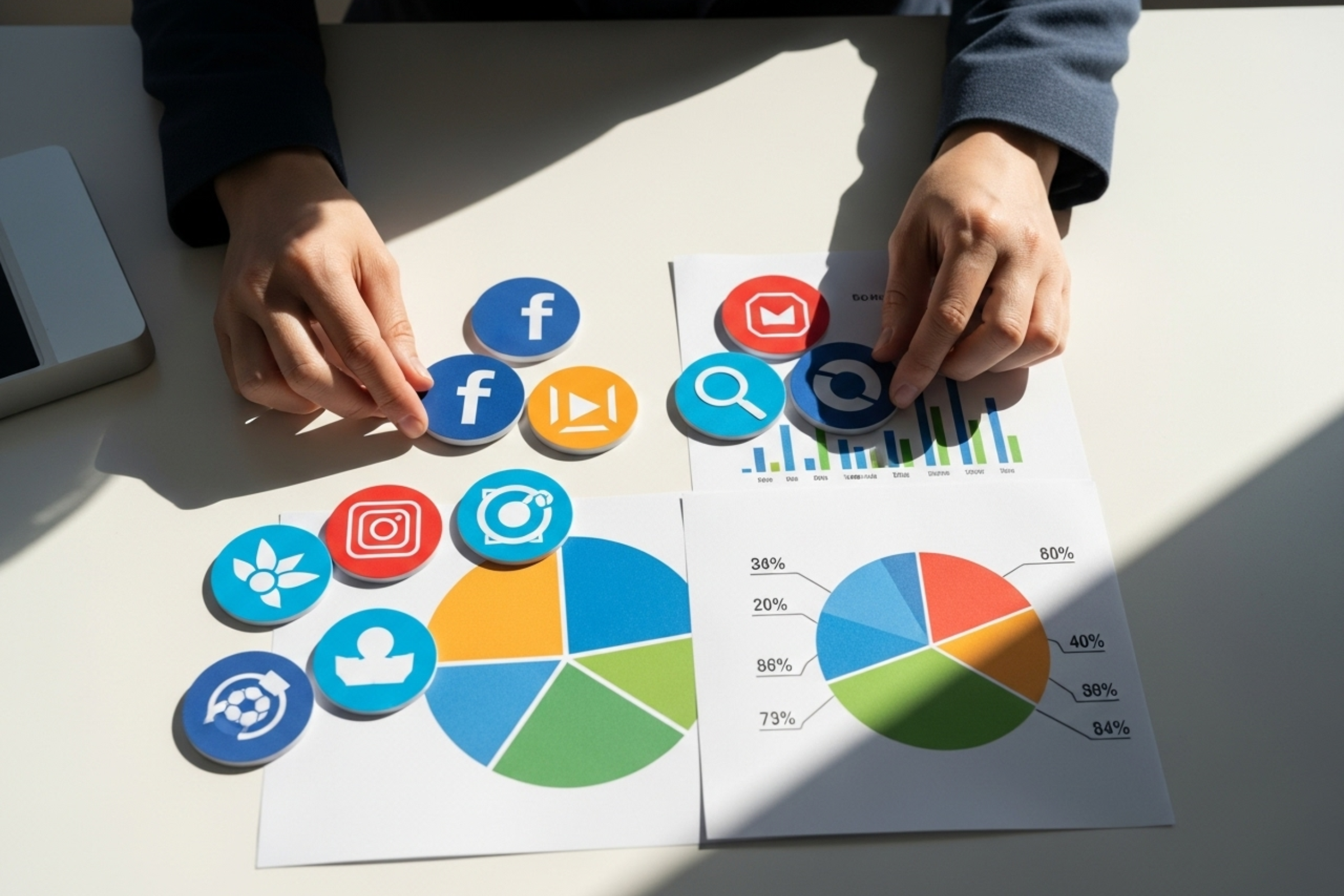Maximizing Your ROI: A Simple Guide to Paid Advertising for Small Businesses
- Exploring the Best Advertising Channels: Choosing Where to Invest Your Budget
- Affordable Paid Advertising Tactics: Maximizing ROI with Smart Strategies
- How AI Marketing Tools Revolutionize Content Creation and Campaign Performance
- Putting It All Together: Step-by-Step Actions for Effortless Paid Marketing
In today’s digital landscape, small businesses face unprecedented competition—not just from local rivals, but from countless online voices vying for attention. With new content flooding social media and search engines every second, organic reach is steadily shrinking. This means that even the most creative, high-quality posts often struggle to get in front of potential customers without a helping hand.
That’s where paid advertising steps in. By investing even a modest amount, businesses can break through the noise and put their message directly in front of people who matter. Paid ads come in various forms, with some of the most popular options being Pay-Per-Click (PPC) campaigns, such as Google Ads, and visually engaging social media ads on platforms like Facebook and Instagram. These channels let you target audiences by location, interests, behavior, and more—ensuring your budget is used efficiently.
Many small business owners worry that paid advertising is costly or too complex, but today’s tools are designed to be accessible even on tight budgets. Whether you’re spending $50 or $500 a month, paid advertising can deliver measurable results, helping you increase visibility, drive traffic, and boost sales. Ultimately, the key advantage is control: you decide who sees your ads, when, and how much you want to spend, making it a scalable and flexible way to grow in a crowded market.

Exploring the Best Advertising Channels: Choosing Where to Invest Your Budget
- Importance of aligning channels with business goals.
- Overview of main platforms: Google Ads, Facebook, Instagram, LinkedIn, TikTok.
- Examples of matching business needs to platforms.
- Benefits of starting small and testing.
- Adapting based on results and audience response.
Choosing the right advertising platform is essential to making the most of your marketing budget. Not every channel suits every business or objective, so the first step is to clearly define what you hope to achieve. Do you want to drive more traffic to your website, generate new leads, build brand awareness, or directly increase sales? Your answer will help you select the most effective platforms.
Google Ads is perfect for capturing active intent—when someone searches for a product or service you offer, your ad appears exactly when they’re ready to act. Social media platforms, like Facebook and Instagram, are excellent for building brand awareness and engaging users through visuals and stories, with powerful demographic and interest-based targeting. LinkedIn is tailored for B2B marketing, making it a top choice for services targeting professionals and decision-makers. If your audience is younger or your brand thrives on creativity, TikTok offers a unique opportunity for viral, video-driven promotion.
Consider these examples: A local service provider could use Facebook’s location targeting to attract nearby clients. Sellers of digital products nationwide might find Google Ads more effective, reaching people actively searching for solutions. For B2B tools, LinkedIn’s professional filters are invaluable. The best approach is often to start small—choose one or two platforms that align with your objectives and test the waters. Monitor how your audience responds, and be ready to adapt your strategy as you discover what works best for your business.

Affordable Paid Advertising Tactics: Maximizing ROI with Smart Strategies
- Setting realistic budgets and starting small.
- Focusing spend on high-performing channels using analytics.
- Using A/B testing to optimize ads.
- The role of retargeting in improving conversions.
- Avoiding common mistakes and staying flexible.
The beauty of paid advertising today is that you don’t need a large budget to see results. Start by setting a budget that feels comfortable—many small businesses succeed with as little as $50 to $300 per month. The secret lies in spending wisely: direct your budget toward channels and campaigns that show the highest engagement using built-in analytics tools.
A crucial tactic is A/B testing, where you run different versions of your ads to see which headlines, images, or calls-to-action perform best. This process removes guesswork and helps you refine your message for maximum impact. Another powerful strategy is retargeting, which reminds people who have previously visited your site or engaged with your content to come back and complete their purchase or inquiry. Retargeting dramatically improves conversion rates by keeping your brand top-of-mind for interested prospects.
Be sure to avoid common pitfalls, such as setting daily budgets too high or forgetting to set campaign end dates, which can lead to runaway costs. Stay flexible—pause or adjust campaigns based on real-time performance data. Remember, marketing is an ongoing process of learning and refining. By continuously analyzing results and making small tweaks, you’ll stretch your advertising dollars further and see better returns over time.

How AI Marketing Tools Revolutionize Content Creation and Campaign Performance
- AI tools simplify ad creation and campaign management.
- Campaign automation for setup and optimization.
- AI-powered content creation (headlines, visuals, calls-to-action).
- Real-time analytics and budget reallocation.
- Personalization and audience segmentation.
Artificial intelligence is transforming how small businesses approach paid advertising, making advanced marketing techniques accessible to everyone. Modern AI marketing tools can now handle many of the tasks that once required a dedicated team of experts. From campaign setup to content creation and data analysis, AI streamlines the entire process, reducing the time and expertise needed to launch effective ads.
Campaign automation tools guide you through setting up ads, recommending the best formats, budgets, and scheduling based on your objectives and target audience. AI-powered content generators help craft compelling headlines, calls-to-action, and suggest relevant visuals, all tailored to resonate with your market—speeding up production and ensuring your messaging stands out.
One of the most valuable features is real-time analytics. AI can automatically identify which ads are performing best and reallocate your budget to those high-converting campaigns, maximizing your return without manual intervention. Advanced personalization is another game-changer: AI segments your audience based on their behavior and preferences, delivering tailored messages that increase engagement and conversions.
For small business owners, these smart solutions not only save time and reduce guesswork but also level the playing field with larger competitors. Even without a marketing background, you can now run sophisticated, data-driven campaigns that drive real results.

Putting It All Together: Step-by-Step Actions for Effortless Paid Marketing
- Recap of key steps: goal-setting, platform selection, budgeting, testing, AI integration.
- Importance of ongoing tracking and adaptation.
- Immediate action checklist for readers.
- Encouragement to start small and iterate.
- Empowering message for small business owners.
Embarking on a paid advertising journey may seem daunting, but breaking it down into manageable steps makes it achievable for any small business. Start by defining a single, clear campaign goal—whether it’s driving more website traffic, generating leads, or boosting sales. Next, select one or two advertising platforms that best align with your audience and objectives, based on the strengths outlined earlier.
Set a budget that matches your comfort level, and begin testing different ad variations. Monitor results closely, using built-in analytics or AI-powered tools to identify what’s working and where adjustments are needed. Don’t overlook retargeting: it’s a highly effective way to turn interested browsers into loyal customers.
Leverage AI tools for both content creation and campaign management to save time and amplify your impact. These smart solutions simplify everything from generating creative ad copy to automatically optimizing your budget and audience targeting.
To get started today, follow this action plan:
- Define one clear campaign goal (traffic, leads, or sales).
- Choose the advertising platform that fits your business and audience.
- Set a manageable monthly budget and run A/B tests on your ads.
- Integrate AI tools for content creation and performance analytics.
- Track your results, stay flexible, and refine your approach based on data.
Remember, marketing success is built on continuous learning and small, consistent improvements. By taking these steps, you’ll empower your business to thrive in a crowded digital landscape—no matter your budget or experience level.